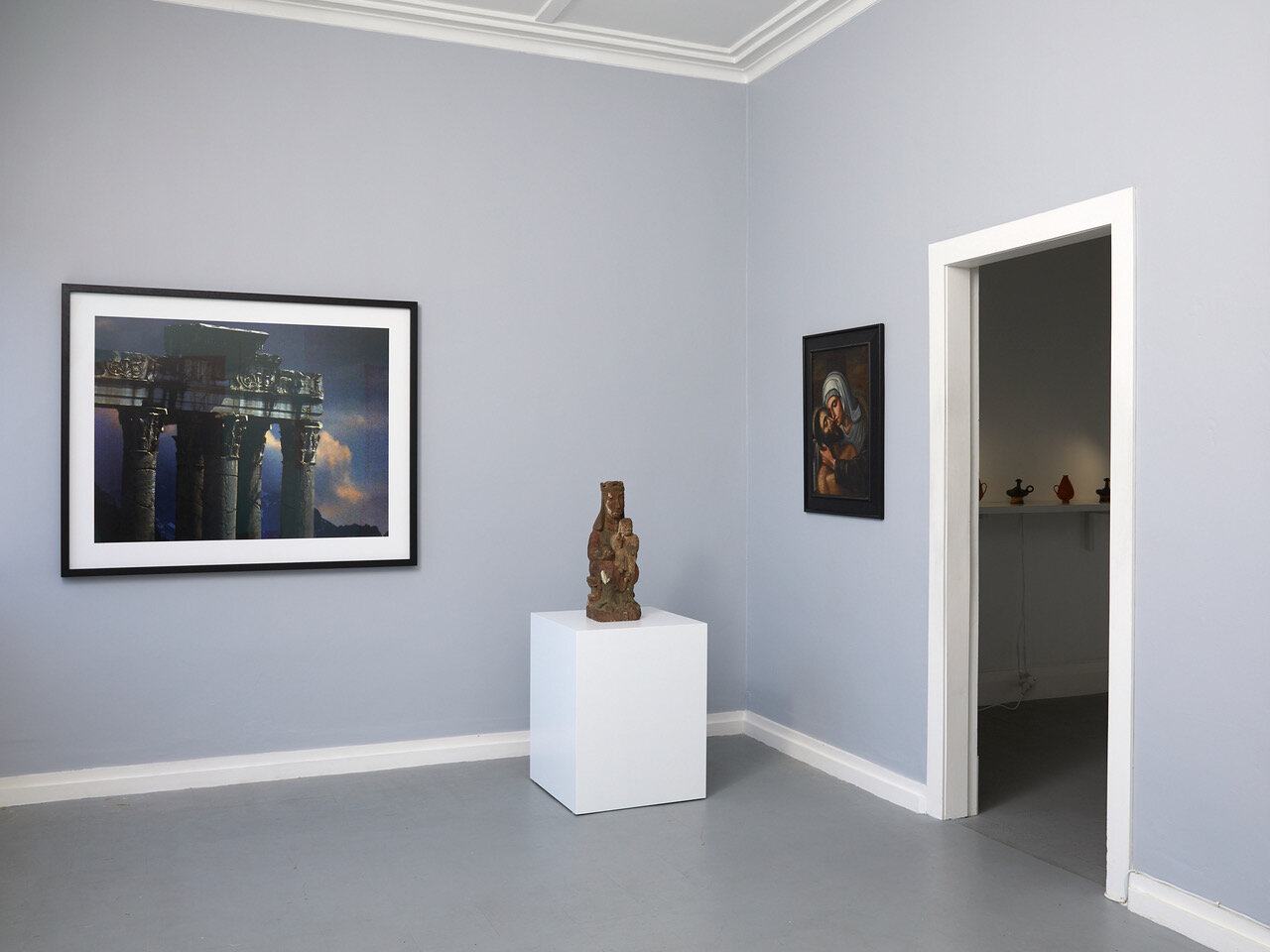
PROVENANCE II
From 26th November 2019
European Antiquities and Old Masters
With:
Bill Henson, Marcel Dzama, Jalal Asgher,
Janet Beckhouse, Kushana Bush,
David Cauchi, Tony de Lautour, Jason Greig,
Louise Greig, Michael Harrison, Andrew McLeod,
Peter Madden, Liz Maw, Tanja Nola, Martin Selman,
Yvonne Todd, Francis Upritchard
Ronnie van Hout, John Ward Knox
Image (left to right):
Bill Henson
Untitled CL SH645 N10
2009/16
archival inkjet pigment print, edition of 5 + 2 AP
1080 x 1330mm
Madonna and Child (Sedes Sapientiae
12th - early 13th century, Northern Europe (probably Spain)
580 x 210 x 170mm
Pieta
17th century, Spain
620 x 440mm
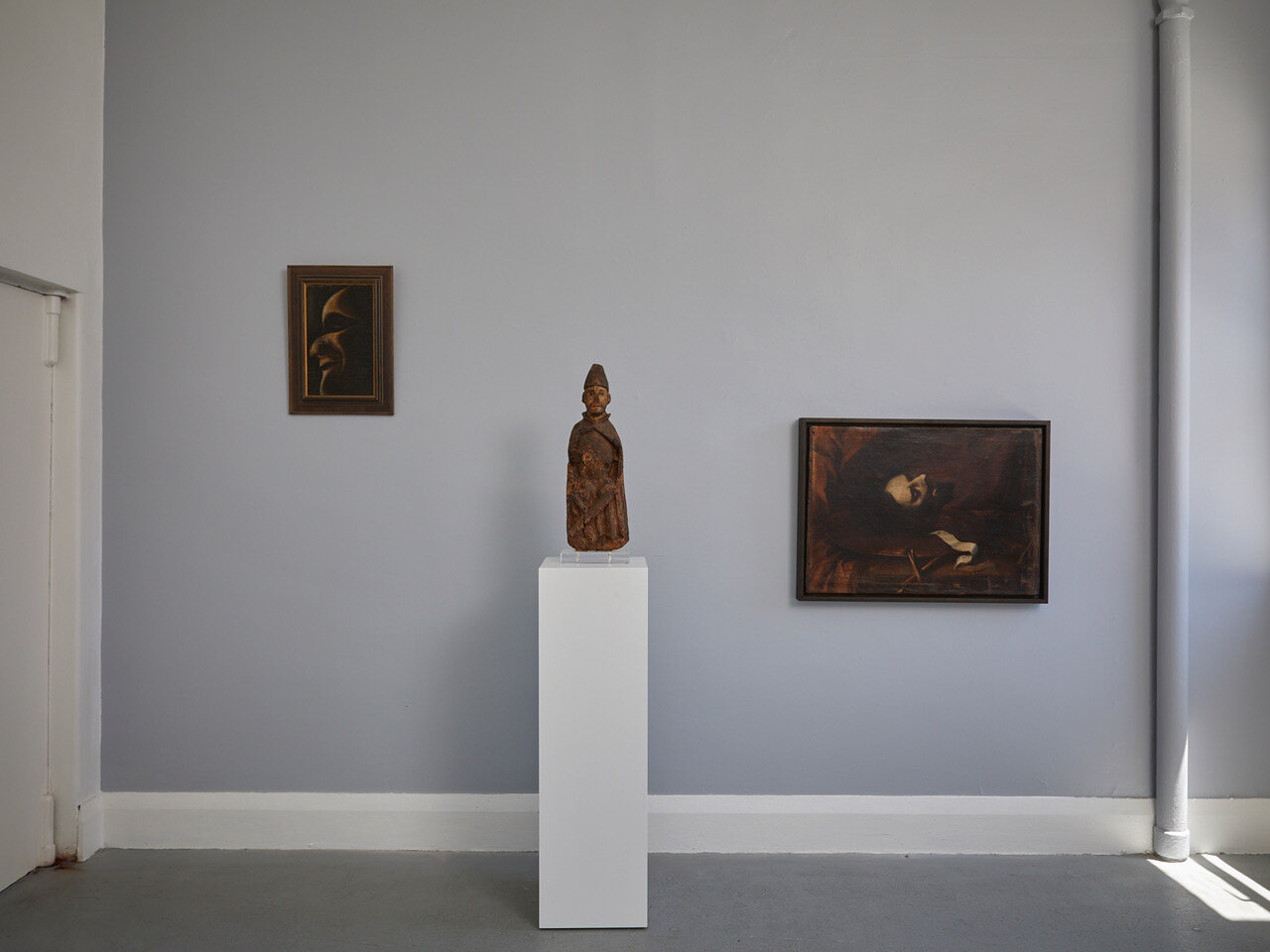
Left to right:
Tony Fomison
Clown
1975
oil on hessian on board
365 x 220mm
Romanesque Statue
Late 13th - early 14th century, Iberian (probably Pyrennes)
590 x 200 x 95mm
The Head of John the Baptist
17th century, Sevillian school (possibly from the workshop of Sebastian de Llanos Valdés)
555 x 770mm

Left to right:
Judith
18th century, Spain or a Spanish colony (possibly Equador)
480 x 330 x 170mm
Tanja Nola
Royal Blue Velvet Pot
2019
raw clay, stoneware, earthenware, porcelain, ceramic pigment and oxide, glass, copper, diamond dust, ceramic scraps
250 x 260 x 280mm
Tanja Nola
Stick Rock Pot
2019
raw clay, stoneware, earthenware, porcelain, ceramic pigment and oxide, glass, diamond dust, ceramic scraps
175 x 290 x 210mm
Scytho-Sarmatian Bronze Vessel
Late Scythian, 3rd - 2nd century BC, Scytho-Sarmatian, Crimea
250 x 210 x 140mm

Yvonne Todd
Geranium
2019
c-type print from 4x5 transparency film, edition of 3 + 2 AP
1200 x 940mm

Left to right:
Roman Red-Slip Terracotta Jug (2)
Late Imperial Period, 3rd century AD, North African (Tunisia)
180 x 120 x 100mm
Campanian Black-Glazed Guttus
Hellenistic period, 2nd half of the 4th century BC, Western Greek, Campania
135 x 150 x 115mm
Roman Red-Slip Terracotta Jug (1)
Late Imperial Period, 3rd century AD, North African (Tunisia)
150 x 101 x 90mm
Apulian Black-Glazed Guttus
Hellenistic period, 2nd half of the 4th century BC, Western Greek, Apulia
130 x 140 x 155mm

Bill Henson
Untitled CL SH645 N10
2009/16
archival inkjet pigment print, edition of 5 + 2 AP
1080 x 1330mm

The Virgin of the Annunciation
15th century, Bohemia (Czech Republic)
430 x 260 x 150mm
Provenance: Private collection, Madrid, Spain.
A very fine carved alabaster statue of The Virgin of the Annunciation, surprised in her spiritual meditations by the apparition of the archangel Gabriel, announcing her conception of the Christ child. This statuette’s sensitively carved features and slight smile, elongated proportions, and graceful draperies show stylistic analogies to courtly art in Paris. In fact, this is a very direct copy of the early 14th century French limestone Virgin of the Annunciation (1300 - 1310, 424 x 296 x 188mm) now housed in the Metropolitan Museum of Art, New York.
A comparable piece was catalogued by the French Haute Epoque expert and art consultant, Laurence Fligny. Fligny designates the piece as Central European, Bohemian or Pomeranean, c. 1420/1430. Both of these pieces would appear to belong to the same period of artistic creativity in early 15th century Bohemia.
King Charles IV of Bohemia (c.1316 - 1378) was determined to rebuild his capital city Prague in the image of Paris and Rome, and to turn it into a hub of learning, spirituality, and the arts. A new generation of Bohemian artists drew specifically on international prototypes (such as the Paris Virgin) to embellish Charles’ building projects. This artistic activity continued well after Charles’ death in 1378. Amongst the many iconic religious images produced around 1400 were a series of paintings and sculptures of ‘Miraculous Madonna’s’, many of whom inspired intense cult followings. These images expressed a distinct aesthetic, known as ‘The Beautiful Style’, which depicted Mary as a courtly medieval princess. These so-called ‘Beautiful Madonna’s’ are characterised by an affected elegance; typically, cascading folds of drapery cover a demure female figure poised in an exaggerated ‘S’ stance. The facial features are similarly distinctive; a girlish face with a high smooth forehead, delicate chin and lips, and almond eyes. The necks are elongated and curved, the shoulders narrow, and the fingers of the hands long and tapering. All of these features are very evident in this sculpture, dating it to the early 1400s. Early alabaster figures almost always show traces of polychromy and/or gilding — or glazing intended to make them resemble bronze, since the most admired and technically impressive statues from antiquity were cast in this material. The patination on this piece is suggestive of this kind of ‘bronze’ glazing.

Marcel Dzama
Neither more nor less or Neither simple nor straightforward
2014
watercolour, gouache, collage and graphite on paper (ex David Zwirner, New York)
430 x 355mm

Martin Selman
Tondo
2019
Carrara marble
750 x 750 x 55mm

Martin Selman
Il Braccio Destro
2019
Carrara marble
260 x 580 x 400mm

Martin Selman
Travertine Fracture
2019
Iranian travertine
180 x 255 x 370mm

Pieta
17th century, Spain
620 x 440mm
Provenance: Private collection, Spain.
Oil on canvas depicting ‘The Piety’; the grieving Virgin Mary cradling the bloodied head of Christ after his descent from the cross. Produced by a follower of the earlier works of Luis de Morales (c. 1512 - 9 May 1586), a Spanish painter born in Badajoz, Extremadura. Known as "El Divino", most of his work depicted religious subjects, including many representations of the Madonna and Child and the Passion. Morales’ paintings were characterised by his stylised, primitive approach to form, and his vivid and expressive representations of physical and emotional pain. These works combined the aesthetics of the Flemish Primitives (such as Van de Weyden) with a darkness that foreshadowed Caravaggio and the Spanish Baroque. Morales was much admired and copied in his lifetime and beyond, and he was one of a number of old masters who inspired the late New Zealand artist Tony Fomison's religious images.

Saint Francis
Late 16th century, Bologna, Italy
945 x 710mm
Provenance: Antichitarte Lda, Caserta, Italy.
Oil on canvas depicting Saint Francis of Assisi in meditation. With a gilded frame bearing a plaque with the attribution ‘Luis Carrache’. This is a reference in French (the painting must have been part of a French collection at one time) to Ludovico Carracci (c. 1555 - 1619).
Born in Bologna in 1555, the son of a butcher, Lodovico Carracci grew up under the same roof as his cousins Agostino (c. 1557-1602?) and Annibale (c. 1560-1609), who became his closest collaborators. Around 1582 Lodovico and his cousins Agostino and Annibale founded an academy that emphasised drawing from life and offered an opportunity to study optics, anatomy, and other subjects considered important to painters. The three artists worked together so closely in their early years that in many cases scholars have found it difficult to distinguish between their hands. A conscious experimentation with style was a hallmark of the early Carracci Academy as the Carracci attempted to reform the formal, affected elegance of the prevailing late mannerist style with an infusion of nature, comprehensibility, human warmth, and authentic expression.
After the departure of his cousins for Rome in the mid 1590s, Lodovico remained in Bologna to head the Carracci Academy and thriving studio. He traveled little and reluctantly. During this period he produced his more significant works, at least in terms of their impact on subsequent generations of artists. The sensuous quality of his paint, the powerful, tangible evocation of solid form, the innovative chiaroscuro, and dynamic approach to composition, opened a path toward the baroque style.
Until the end of his life, Lodovico was inundated with commissions from important patrons both in Bologna and elsewhere in northern Italy, and his works commanded the highest prices. His late style is emphatically didactic and oscillates, depending upon the subject, from the stern and austere to finely-spun ethereal effects. This painting of St Francis seems likely to come from this period, since it is technically sophisticated compared to Ludovico’s earlier works, and combines sombre asceticism with delicate detailing, such as the blue veins in the saints hands, the patination of the skull, and the darkened atmosphere of his cell.

Orthodox Icon of Christ the Pantocrator
Mid-late 18th century, Western Russian (probably St Petersburg)
350 x 265 x 65mm
Provenance: Private family collection of a Russian emigre, Rhode Island, USA.
An Orthodox icon painted in oil on a wooden panel and covered with a heavy, carved, repoussé silver covering (called an oklad). The subject is Christ as the Pantocrator, or teacher of men. This is very common theme in Orthodox iconography, but this particular icon shows Christ in a more sophisticated three-quarter view, as opposed to a frontal view which is the more typical presentation. Traditionally icons were painted in egg tempera and the figuration was highly stylised, but in the mid 18th century the influence of Western portrait painting produced a new type of icon, painted in oils and offering more naturalistic and humanised images. The silver coverings or oklads were commissioned by families for icons which had proven effective in focusing prayers and producing results. In this way the icon was protected (from dirt and smoke from incense and icon lamps) and also honoured.
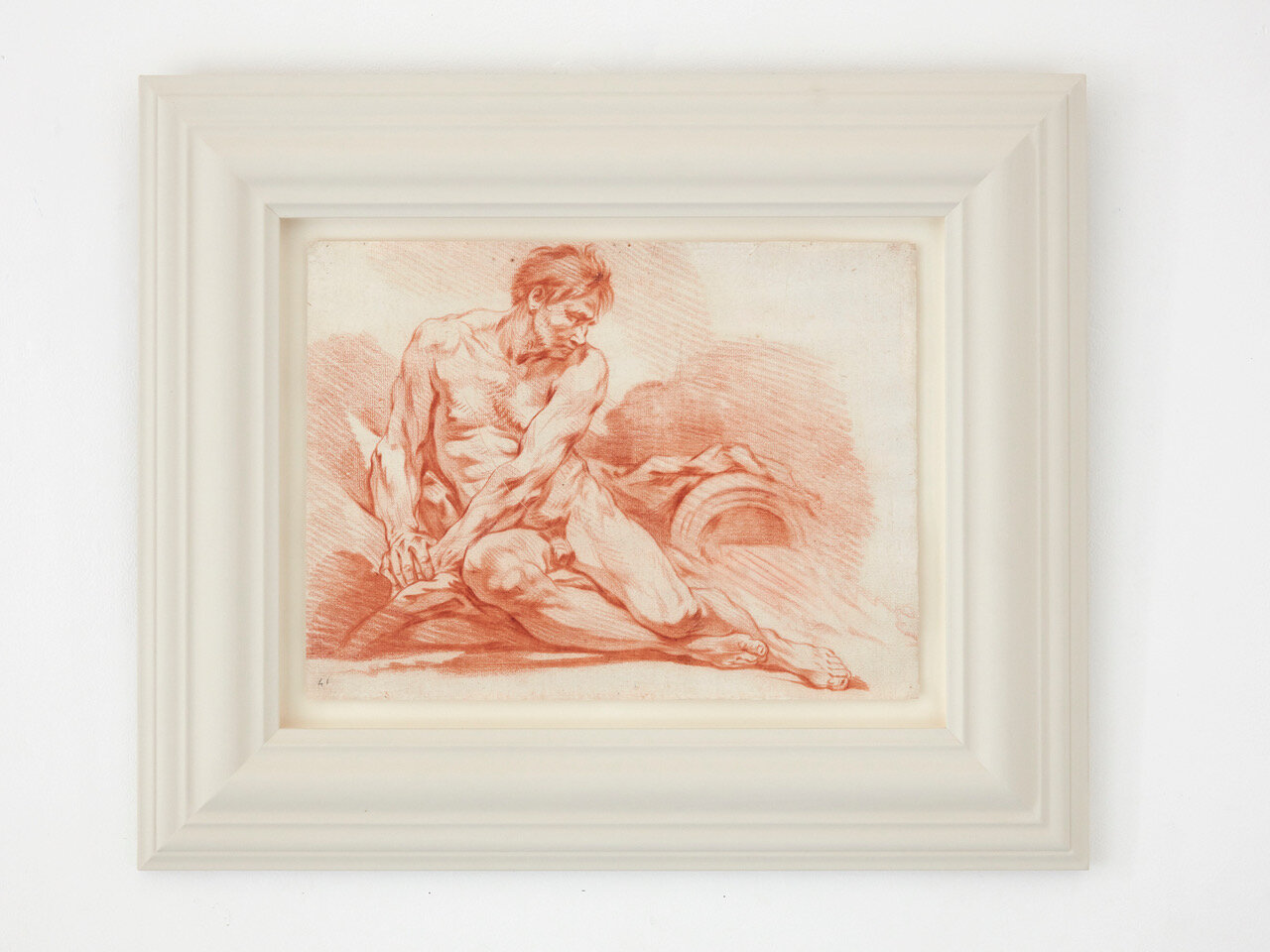
Drawing by François Boucher
1703-1770, Paris
275 x 370mm
Provenance: Private collection, Spain.
An academic drawing in sanguine chalk depicting a male nude. François Boucher (c. 1703–1770) was a French Rococo painter, engraver, and designer, who epitomised the frivolity, elegance, and extravagance of the French court in the 18th century. His career was hugely successful and he received many honours, becoming Director of the Gobelins factory in 1755 and Director of the Academy and King's Painter in 1765. He was the favourite artist of Louis XV’s most famous mistress, Madame de Pompadour, to whom he gave lessons, and whose portrait he painted several times.
Boucher was also a virtuoso draftsman. Drawings played a large role in the preparation of paintings and as designs for printmakers, as well as being created as finished works of art for the growing market of collectors. For his major canvases, Boucher followed standard studio practices of the time, working out the overall composition and then making chalk studies for individual figures or groups of figures. He was an incredibly productive artist, making thousands of drawings both as sketches and finished works in chalk, ink, and pastels. One of the most notable things about Boucher's superb draughtsmanship is his energetic, economical mark-making. Grace, beauty and power combine with a striking inner force. Such was his popularity that a great number of printmakers found it lucrative to reproduce his paintings and drawings; some 1,500 prints after Boucher are known today.

The Head of John the Baptist
17th century, Sevillian school (possibly from the workshop of Sebastian de Llanos Valdés)
555 x 770mm
Provenance: Private collection, Madrid, Spain.
Oil on canvas of the severed head of John the Baptist, on a metal platter (pewter or copper). Tucked underneath the platter is a thin, crude wooden cross, which is almost always carried by John the Baptist in artistic depictions, and draped over the edge of the plate is a ribbon-like scroll. The severed head is painted in stark pallid tones, which contrast with the deep shadows.
Paintings of the severed heads of martyr saints form part of an artistic tradition that can be traced back to Spanish sculpture from the last quarter of the 16th century. The majority of the painted treatments of this subject were produced by a number of leading Spanish (and especially Sevillian) artists. The earliest known painting of a severed martyr's head is a work by Jusepe de Ribera (1591-1652) of around 1636, depicting The Head of Saint John the Baptist, today in the Real Academia de San Fernando, Madrid. In Seville, Francisco de Zurbarán (1598-1664) painted a set of severed heads of saints for the main altar of the Iglesia de los Mercedarios Descalzos, and in around 1650 Herrera el Viejo (1576-1656) painted two severed heads of saints, one of which is today in the Prado Museum. The majority of unsigned paintings of saintly severed heads from this period were once attributed to Juan de Valdés Leal, but subsequent scholarship concluded that they are most likely to be the work of a student of Herrera el Viejo called Sebastian de Llanos Valdés (c. 1605–1677). It appears that he carved out something of a niche for himself painting severed heads for private patrons.
Valdés' oeuvre consists almost entirely of religious imagery, and his style reflects the artistic traditions of his time, including the deep chiaroscuro used by the ‘Spanish Caravaggio’, Zurbarán. Within Valdés' artistic production lies a significant group of severed heads of martyr saints, most of which appear to date from the 1660s and 1670s. Valdés paints with intense realism, conveying the full physical horror of martyrdom — the decapitated heads displaying a palpable sense of rigor mortis and the pewter dishes splattered with blood from the severed necks. These qualities are very evident in this work, with the lividity of the facial flesh and the grotesquely gaping jaw. It is possible that this painting comes at least from the workshop of Sebastián de Llanos Valdés, if not actually from his own hand.
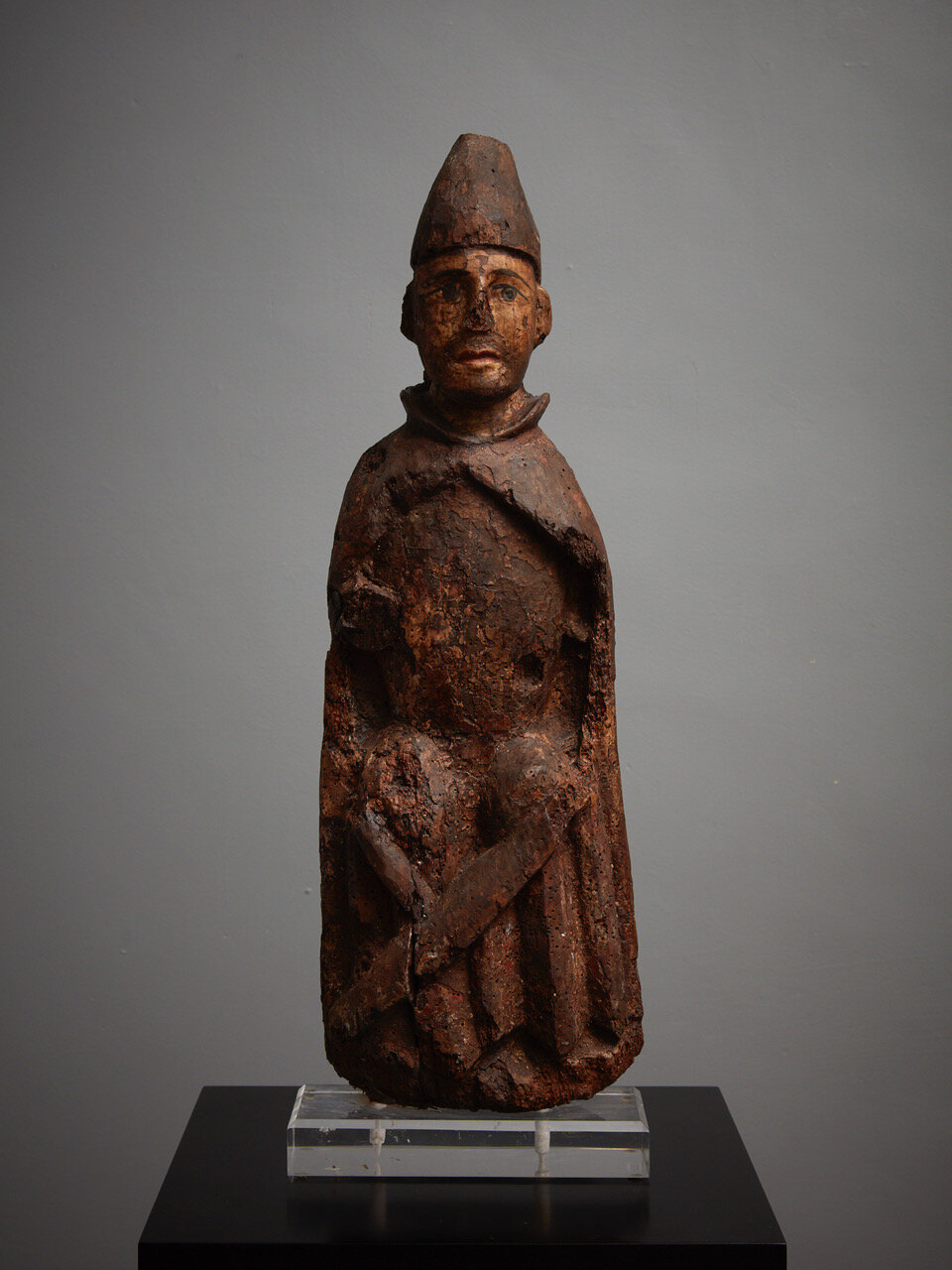
Romanesque Statue
Late 13th - early 14th century, Iberian (probably Pyrennes)
590 x 200 x 95mm
Provenance: Private collection, Madrid, Spain.
A wooden sculpture of a seated male figure, wearing a conical hat, long robe, and cape. This is almost certainly a representation of Saint Peter as the first pope of the Catholic Church. An inverted ‘T’ shaped object rests diagonally against his legs, symbolising Saint Peter’s martyrdom – he was crucified upside down. These images of Saint Peter as Pope were common until the 14th century. The sculpture is very distressed; both arms and feet are missing, as is most of the nose. Traces of polychromy are visible in the dark patina, and the painting of the eyes is still distinct.
The Romanesque world extended roughly from about the late 10th century to around 1200. In Spain, it flourished in the northern half of the country and is notable by its absence in the south, which, despite advances made by the Christian kingdoms of the north, was still firmly held by Muslim al-Andalus. The aesthetic of the piece is characteristic of Romanesque culture – heavily stylised, rigid, and imposing. Its relative simplicity and lack of refinement in the detailing suggest that it is a popular, folk art version of the Romanesque high art made for Cathedrals and noble homes during this period.

Christ Child with Instruments of the Passion
17th - 18th century, Iberian Peninsula School
620 x 495mm
Provenance: Private collection, Madrid, Spain.
Oil on canvas depicting the young Christ child walking alone in a darkening landscape, wearing a red robe and a crown of thorns, and carrying a wooden cross. He looks upwards to Heaven, and emanating from his head are faint rays in the shape of the Tres Potencias (symbolising the three Powers of the Lord: authority, ability, and strength). This is an allegorical painting, most likely commissioned for private devotion, and intended to inspire sympathy and pity for Christ’s suffering. This type of painting seems to have been very popular in the Iberian Peninsula and the Spanish and Portuguese colonies in the 18th and 19th centuries. There are several set pieces of this nature in popular Catholic art which relate to the idea of Christ’s martyrdom being predestined, and which depict Christ as a small child in the presence of symbols of the Passion. One such set piece depicts him sleeping next to a skull (the skull of Adam, often appearing in art at the foot of the cross); another depicts him pricking his finger or foot with a thorn; and another depicts him carrying his cross and sometimes the crown of thorns. This particular painting falls into the latter category of set piece. It is very finely painted, and the Christ child has been rendered with a softness and emotionality which juxtaposes his innocence with the harshness of his fate.

Virgin del Populo
18th century, Continental Europe (most likely Southern Spain or Italy)
160 x 130mm
Provenance: Private collection, Madrid, Spain.
Catholic icon of the Virgin Mary holding the Christ Child, painted in oils on a heavy gauge copper sheet, with a thick application of gilding in the background. The young Jesus is making a gesture of benediction (blessing). This is one of many copies made of an original icon supposedly painted by Saint Luke (who, according to Catholic tradition, was the first icon painter). St Luke’s original version is reputed to have miraculously ended a plague epidemic in Rome in 1231, and thereafter was known as the Sales Populi Romani (The Salvation of the Roman People). The Virgin del Populo became one of the most popular Marian icons through the centuries, attracting many pilgrims to the church of Santa Maria del Populo in Rome, where it is still housed today.
Copies of both Catholic and Orthodox icons — even the smallest and crudest — are felt by the faithful to share something of the miraculous qualities of the original. Hence there was a proliferation of large and small copies of The Virgin del Populo throughout the Catholic world, stretching as far as Eastern and Northern Europe, and the New World. The Virgin del Populo was specially venerated in Italy and Southern Spain, particularly Seville and Cadiz. The sheer popularity of this image makes it hard to determine the origin of this particular version: however, given its provenance, it is most likely to be Spanish.

Bill Hammond
Strap Buddy at the Bone Shop 3
2015
acrylic on canvas
510 x 510mm

Tanja Nola
Bam Bam Chalice Pot
2019
raw clay, stoneware, earthenware, porcelain, ceramic pigment and oxide, glass, ceramic scraps
225 x 340 x 290mm

Tanja Nola
Royal Blue Velvet Pot
2019
raw clay, stoneware, earthenware, porcelain, ceramic pigment and oxide, glass, copper, diamond dust, ceramic scraps
250 x 260 x 280mm

Tanja Nola
Stick Rock Pot
2019
raw clay, stoneware, earthenware, porcelain, ceramic pigment and oxide, glass, diamond dust, ceramic scraps
175 x 290 x 210mm
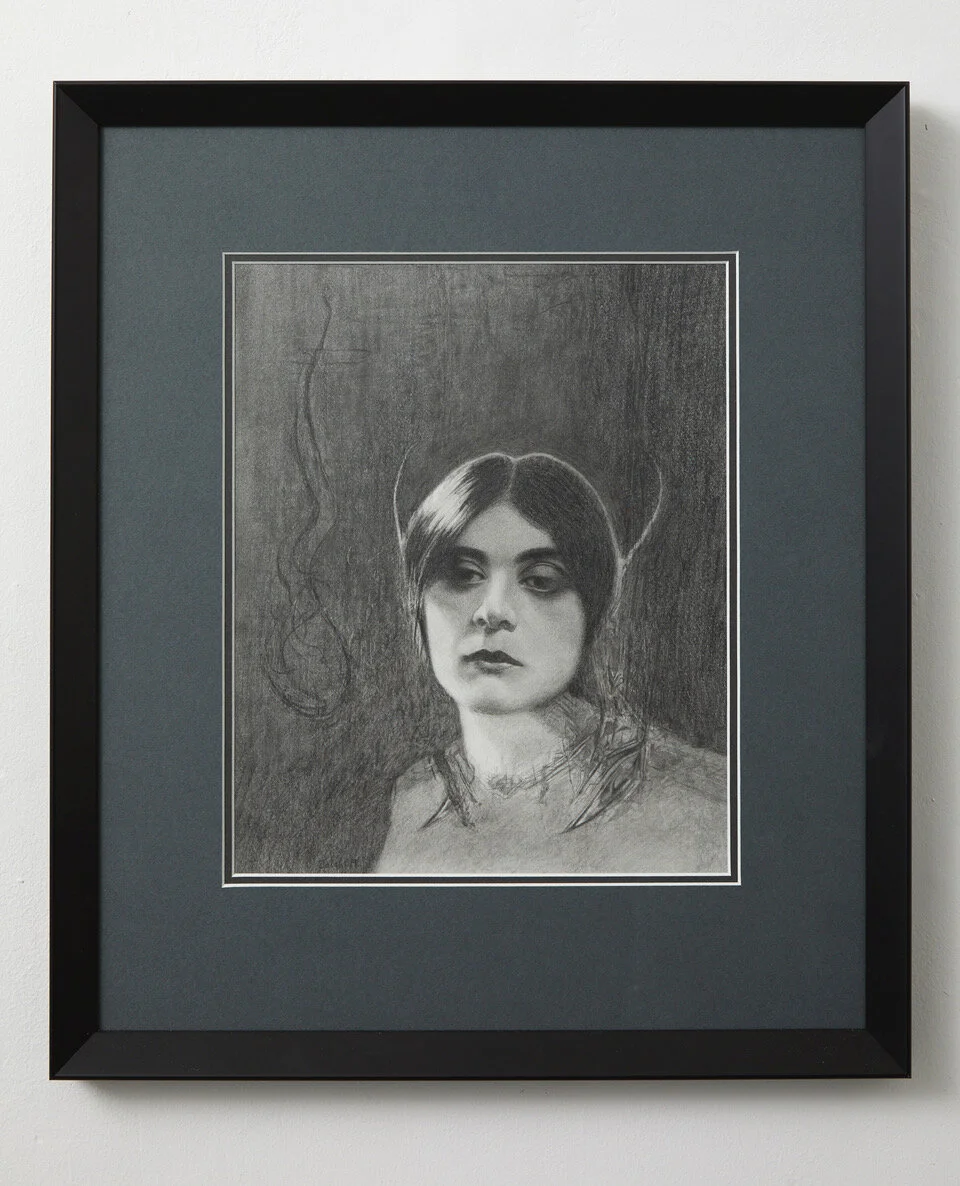
Jalal Asgher
Theda Bara
2019
graphite on paper
320 x 260mm

Jalal Asgher
Musidora
2019
graphite on paper
300 x 250mm

Peter Madden
A Requiem
2019
mixed media collage on board
810 x 710 x 90mm

Memento Mori Plaque (possibly a Plague Marker)
Possibly 17th - 18th century, Barcelona, Spain
1010 x 540 x 95mm
Provenance: Private collection, Barcelona, Spain.
A large wooden plaque, painted black, with a stark, striking skull and crossbones painted in white. The upper section is arched and there is extensive damage to the wooden structure. The skull and crossbones motif and cruder, stylised execution suggest that this plaque could possibly be a ‘plague marker’, or makeshift memorial for the plague dead, who were most often buried in mass graves. Barcelona reportedly had insufficient space in its cemeteries for the plague dead, and as a consequence, many of the mass graves were located in churchyards or under the floors of the churches themselves. This is perhaps the most likely context for a wooden plague marker.

Tony de Lautour
Lightning Inventory I
2019
oil and acrylic on wood
430 x 370mm

Tony de Lautour
Lightning Inventory II
2019
oil and acrylic on wood
430 x 370mm

John Ward Knox
the well
2019
Rimu (Yakisugi treatment), beeswax
155 x 140 x 140mm

Yvonne Todd
Geranium
2019
c-type print from 4x5 transparency film, edition of 3 + 2 AP
1200 x 940mm

Roman Red-Slip Terracotta Jug (2)
Late Imperial Period, 3rd century AD, North African (Tunisia)
180 x 120 x 100mm
Provenance: Private collection, Munich, Germany.
Roman narrow-mouthed piriform vessel distinctive of the North African pottery industry (now modern day Tunisia), with handle and a small foot. Applied relief decoration on the body consisting of three vertical dividing laurel branches with an eagle and a dancing male figure in between, and an arched floral garland above each figure.

Roman Red-Slip Terracotta Jug (1)
Late Imperial Period, 3rd century AD, North African (Tunisia)
150 x 101 x 90mm
Provenance: Private collection, Munich, Germany.
Roman narrow-mouthed piriform vessel distinctive of the North African pottery industry (now modern day Tunisia), with handle and a small foot. Applied relief decoration on the body consisting of two vertical dividing palm branches between which are two figures of Faunus (Roman equivalent of Pan) wrestling with an animal. The handle is restored, but the vessel is otherwise intact.

Liz Maw
Old Money 3
2019
coloured pencil on paper
390 x 275mm

Liz Maw
Old Money 4
2019
coloured pencil on paper
390 x 275mm

Kushana Bush
Just to be loved equally
2019
gouache and watercolour on paper
190 x 270mm

Francis Upritchard
Boo Centaur
2019
Shibuichi (93% copper, 7% silver)
120 x 75 x 25mm

Francis Upritchard
Forward Centaur
2019
Shibuichi (93% copper, 7% silver)
100 x 105 x 30mm

Francis Upritchard
Hooray Centaur
2018
glass, metal lustre
185 x 130 x 135mm

Madonna and Child (Sedes Sapientiae)
12th - early 13th century, Northern Europe (probably Spain)
580 x 210 x 170mm
Provenance: Private collection, Spain.
A softwood Madonna and Child statue, heavily distressed but essentially intact, with traces of polychromy (probably egg tempera). Both figures are rendered in the typical Romanesque style; the composition is formal and frontal, with the Christ child sitting on the Madonna’s left knee. She holds a pomegranate with her right hand, symbolic of the blood and resurrection of Christ, and the Christ’s right arm is raised, his hand making the gesture of benediction (blessing). The Madonna’s face is massive and mask-like, as is that of the Christ, emphasising that they are eternal presences rather than ordinary human beings. As in Byzantine iconography — from which the Romanesque style is derived — the primitive, highly stylised rendering of the Madonna and Child serve to accentuate their sheer spiritual power.
The figure of the Virgin and Child enthroned was a hugely popular iconographical theme particularly during the Middle-Ages. Throughout the 12th century, the Virgin Mary appears in churches all over Europe (France, Germany, Belgium, Scandanavia, England, Italy and Northern Spain) sitting majestically, her body forming Christ’s throne. This kind of presentation is called Sedes Sapientiae, meaning The Throne of Wisdom.

Portrait of an Elderly Nun
18th century, Northern Italy
405 x 320mm
Provenance: Private collection, Genoa, Italy.
A portrait in oil on a wooden panel depicting an elderly Carmelite nun, possibly post-mortem. Portraits of nuns were common in Catholic countries such as Spain — and to a lesser extent, Italy — but particularly in the Spanish colonies of the New World, where nuns enjoyed high standing in society. These portraits tended to be commissioned at very specific stages in the lives of the nuns; for instance, wealthy families often commissioned portraits of their daughters before they entered the convent, in full ‘civilian’ finery, and then afterwards on the occasion of their formal profession of vows. Nuns who had led exemplary lives were also commemorated in portraiture after death, and these were typically displayed within the convent walls. Occasionally, a professional portrait painter would be commissioned to paint a nun (the most famous example being the young Diego Velazquez (1599-1660), who painted three portraits of the elderly Franciscan nun, Jerónima de la Fuente). But most often the painter would be a nun from within the convent (girls with artistic or scholarly inclinations were often drawn to religious orders).
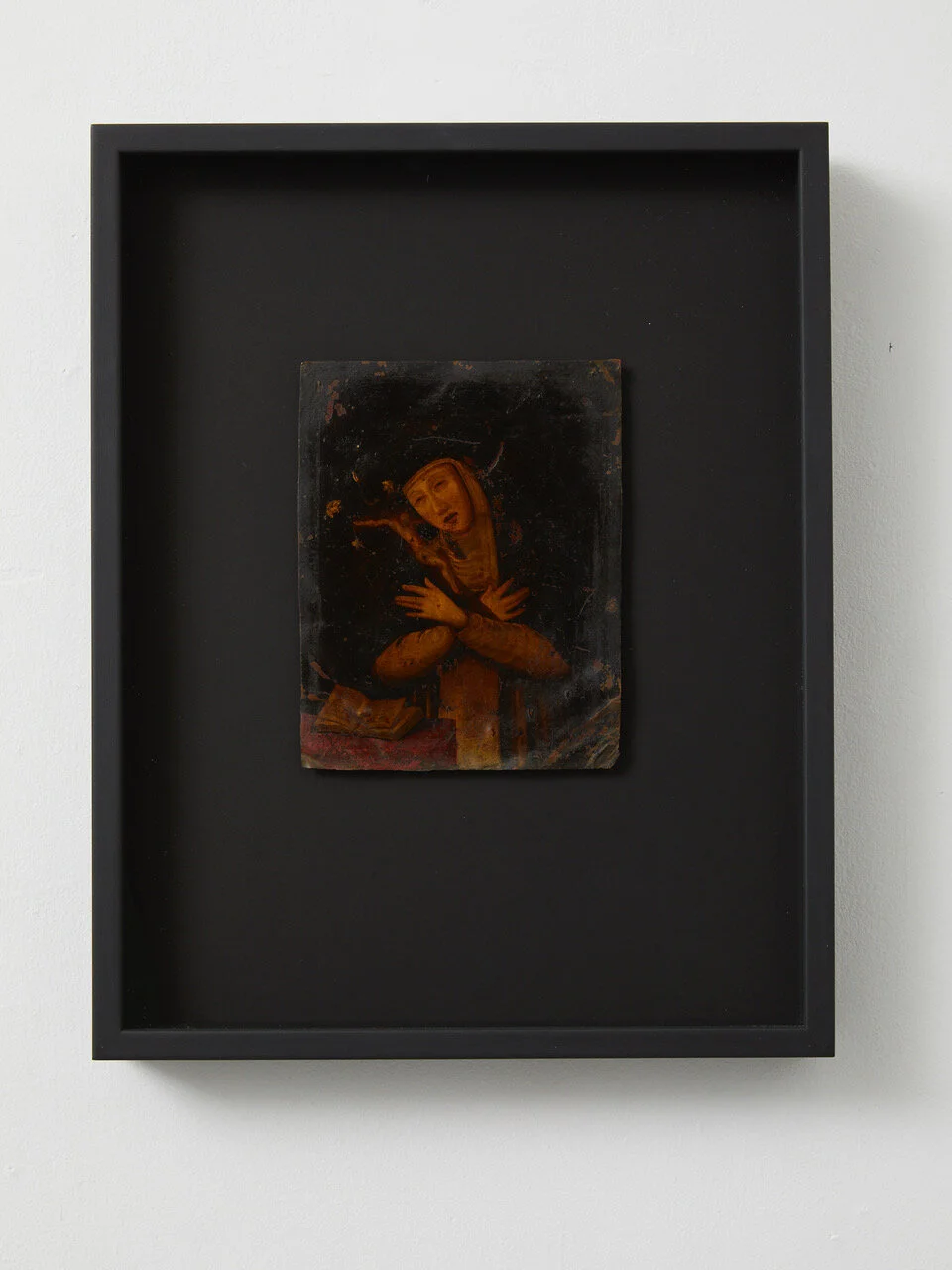
Saint Catherine of Siena in Meditation
17th - 18th century, Continental Europe (probably Spain or Italy)
180 x 140mm
Provenance: Private collection, Madrid, Spain
Catholic icon painted in oils on copper sheet. It depicts the saint Catherine deep in meditation, wearing her characteristic Dominican robes. She holds her usual attributes, a stem of lilies and a crucifix, and is shown before an altar or table upon which a bible lies open. Saint Catherine of Siena was a Dominican tertiary and mystic who lived in Italy in the 1300s. She was known for her holiness, asceticism, and spiritual visions, and was said to have received stigmata. She was also a reformer and political activist, and was influential in both the religious and political affairs of the church. Her image was popular as the subject of small paintings like this, intended for use in the homes of the Catholic faithful.

Scytho-Sarmatian Bronze Vessel
Late Scythian, 3rd - 2nd century BC, Scytho-Sarmatian, Crimea
250 x 210 x 140mm
Provenance: Private collection, South Germany; Exhibition Bonn (2013) p. 259 cat III.10 (Tavrida Central Museum Simferopol, Inv. D-17765 HB).
Scytho-Sarmatian bronze vessel with high foot, conical base, and an oval basin with two handles, each with three protuberances. The surface has a blackish-green patina, and there is a crack beside one handle and a small hole in the base, which shows some evidence of an old repair. The Scythians and Sarmatians were two closely related peoples who populated the Eurasian steppe from roughly the 9th century BC to the 3rd century AD. Both lived in nomadic pastoral societies and were feared in antiquity as formidable horse-back warriors — Scythian warrior women are speculated to have been the historical inspiration for the Amazons of Greek mythology. They are known for producing masterful metalwork, particularly in bronze and gold. Archaeological and documentary evidence also shows that Scytho-Sarmatian peoples adorned themselves in tattoos, enjoyed smoking hemp, drinking wine and fermented mares’ milk.

Michael Harrison
King and Queen of Swords
1999
acrylic on paper
300 x 250mm

Campanian Black-Glazed Guttus
Hellenistic period, 2nd half of the 4th century BC, Western Greek, Campania
135 x 150 x 115mm
Provenance: L.J. collection, Netherlands; Private collection, USA.
Campanian black-glazed guttus made from toned clay with ribbed body and ring handle. Decorated with moulded medallion of a satyr head with goat horns. Satyrs were part of the Thiasus, or entourage of the god Dionysus. The surface is partially rubbed, but the guttus is otherwise intact. Western Greek is a term, which refers to objects produced in Greek colonies in Southern Italy. These small vessels were used to slowly pour liquid in drops — probably in the context of religious rituals such as sacrifices.

Apulian Black-Glazed Guttus
Hellenistic period, 2nd half of the 4th century BC, Western Greek, Apulia
130 x 140 x 155mm
Provenance: Private collection, West Germany.
Apulian black-glazed guttus made from toned clay with ribbed body and ring handle. Decorated with a plastically moulded frontal bust of Pallas Athena, the Olympian goddess of wisdom and war, amongst other things. There are two small chips on the foot of the vessel, but it is otherwise intact. Western Greek is a term which refers to objects produced in Greek colonies in Southern Italy. These small vessels were used to slowly pour liquid in drops — probably in the context of religious rituals such as sacrifices.
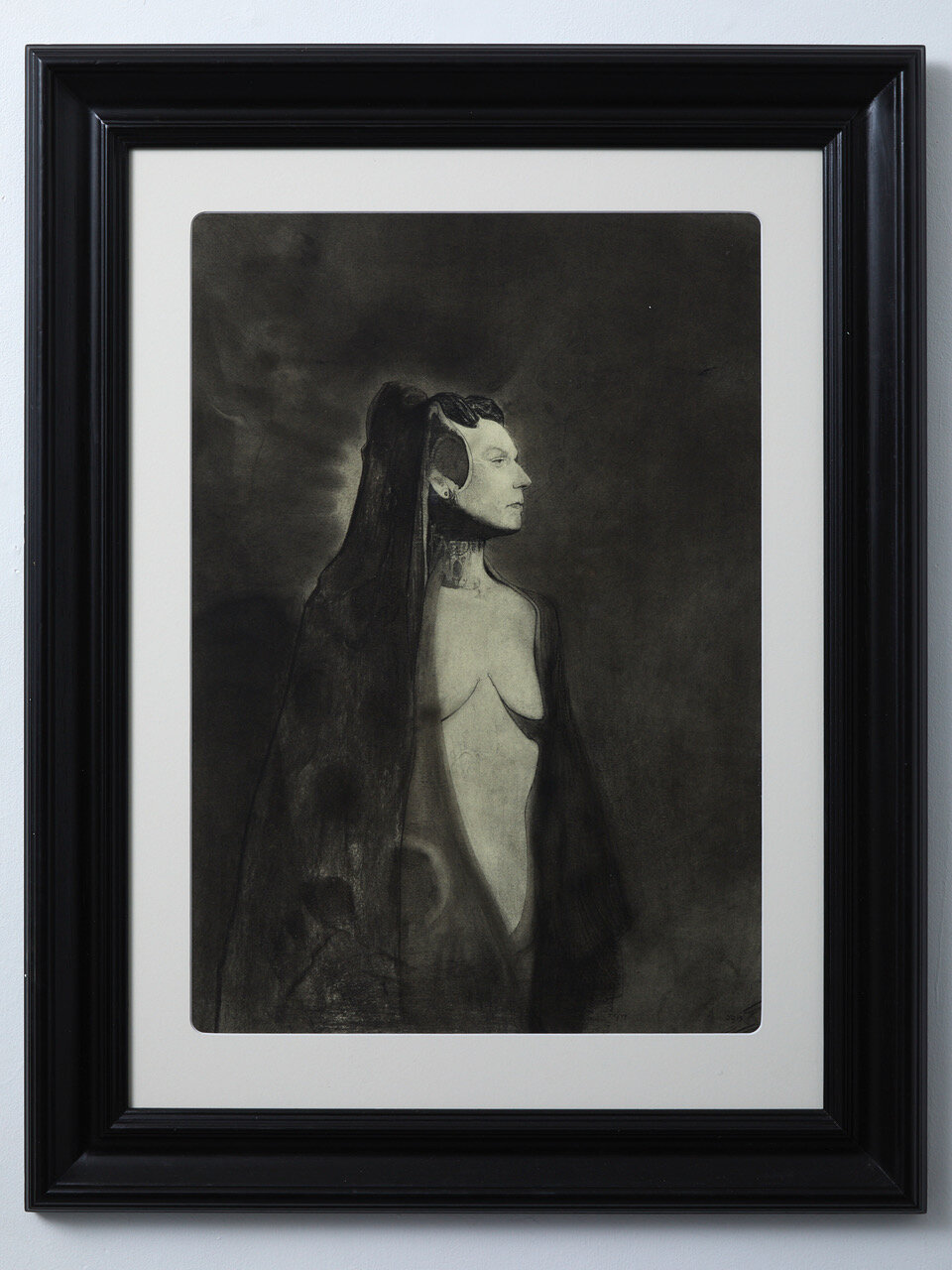
Jason Greig
Matriarchal Mary
2019
charcoal on paper
620 x 430mm

Bronze Enkolpion
Middle Byzantine Period, 10th - 12th century AD, Byzantium (Eastern Roman Empire)
60 x 40 x 5mm
Provenance: Private collection, Munich, Germany.
Half of a bronze enkolpion (medallion) with engraved figure standing in the attitude of Orans (a posture of prayer and supplication) and wearing a long robe, with nimbus and cross, and two stars flanking each hand of the figure. Green patina, minor damages at the hinges. These cruciform reliquaries were worn around the neck and many were produced in such a way as to hold a secondary relic (such as a piece of a saint’s clothing or hair, or a piece of the True Cross). They are believed to have substituted the use of bullae (pendants containing amulets against incantations), which were worn by Romans prior to Christian conversion. In this way, it can be regarded as an object, which bridges the Graeco-Roman and Christian worlds presented in Provenance II.

Bill Hammond
Colour Plate
1996
crayon on paper
600 x 735mm

Alabaster Triptych
Italy
320 x 475 x 95mm
Provenance: Private collection, Madrid, Spain
A travelling icon with fine bas-relief carving on alabaster, mounted on three hinged panels covered with deep red velvet. The central panel depicts the Virgin and Child in a loving pose which may have been inspired by Donatello’s (1386-1466) Pazzi Madonna (1420). The wings of the triptych each depict two of the four evangelists, holding scrolls representing their gospels. The aesthetic of the figures is very much in the style of 14th - 15th century Catholic iconography.

Vanitas with a Monk
17th - 18th century, Continental Europe
170 x 95mm
Provenance: Private collection, Spain.
A very distressed painting in oils on copper sheeting, depicting a skeletonised monk in a white robe praying before a crucifix. Images of ‘living skeletons’ like this piece are part of a larger tradition of darkly satirical Vanitas images on the theme of mortality and the ultimate vanity of human activity.

The Divine Child
16th - early 17th century, Spain
250 x 125 x 95mm
Provenance: Private collection, Madrid, Spain.
A small, very early wooden sculpture of the infant Jesus. Heavily patinated with old losses to the paintwork and gesso on the knees, torso and face, and is missing both arms (which seem to have been carved separately and attached in such a way that they could be manipulated to create different gestures). The hair is deeply carved into curls and the legs are crossed in a sitting position. The face is more crudely fashioned, with the eyes protruding from the plane of the face, whereas later pieces would probably have had inset glass eyes. This piece could have originally been part of a large Madonna and Child grouping — held aloft in the arms of the Madonna. Alternatively, it could possibly have been a stand alone piece representing the Santo Nino or ‘The Divine Child’, possibly with one hand holding a blue globe representing the world, and the other raised in the gesture of benediction (blessing).

David Cauchi
The Look
2019
oil, watercolour and coloured pencil on linen
400 x 300mm

Andrew McLeod
Areez with marble relief
2019
oil on linen
400 x 555mm

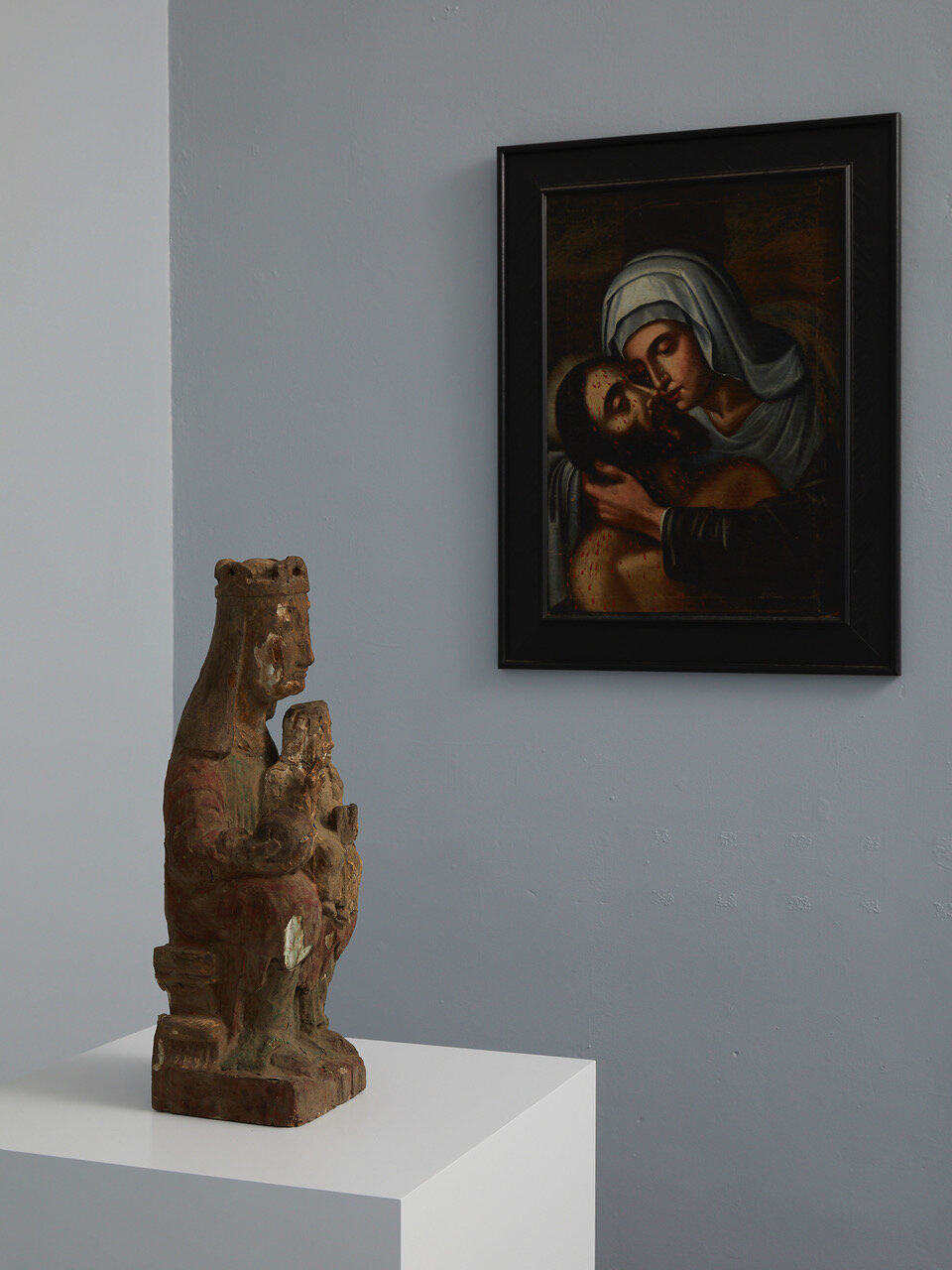
Left to right:
Madonna and Child (Sedes Sapientiae)
12th - early 13th century, Northern Europe (probably Spain)
580 x 210 x 170mm
Pieta
17th century, Spain
620 x 440mm
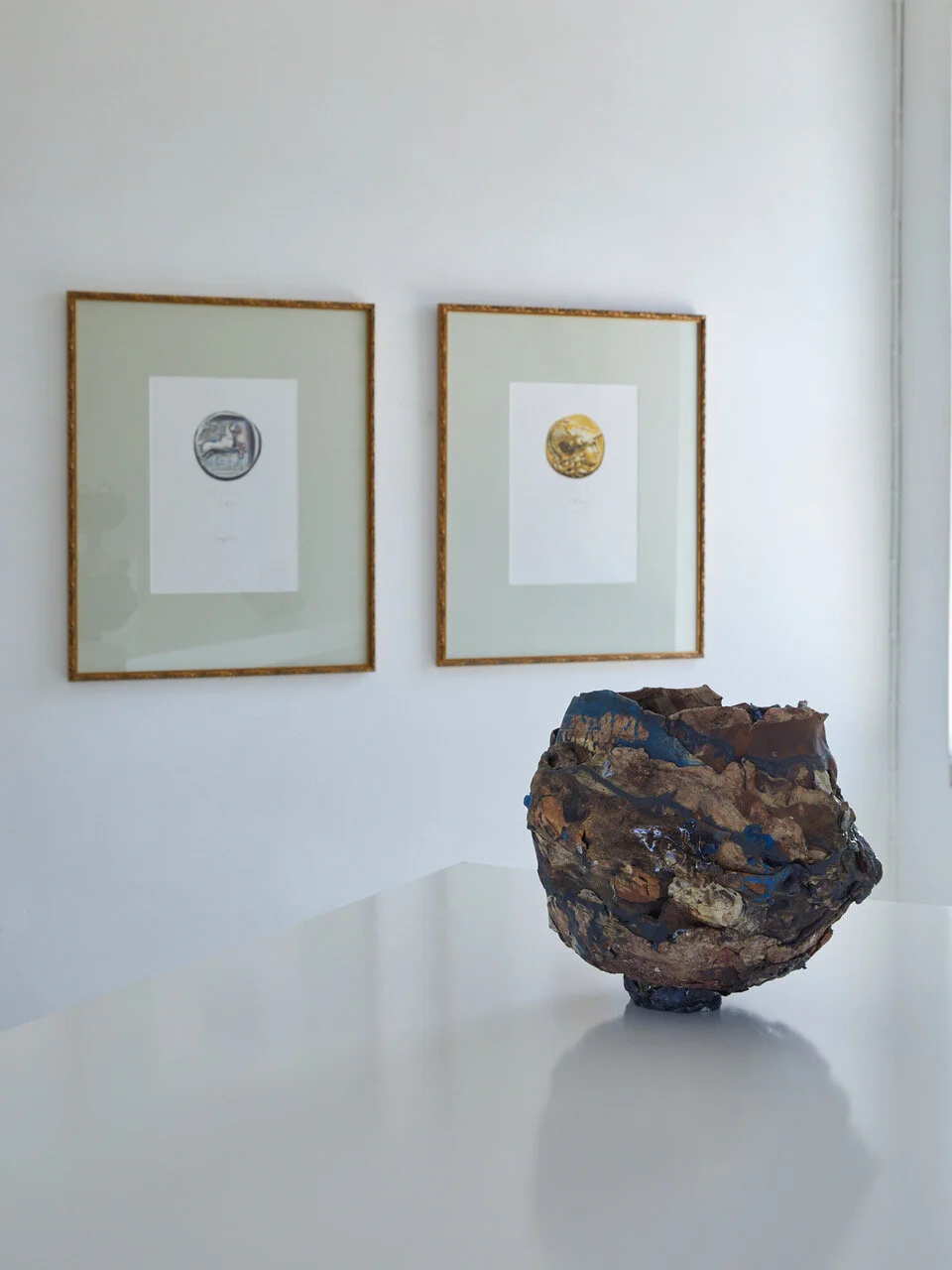
Left to right:
Liz Maw
Old Money 3
2019
coloured pencil on paper
390 x 275mm
Liz Maw
Old Money 4
2019
coloured pencil on paper
390 x 275mm
Tanja Nola
Royal Blue Velvet Pot
2019
raw clay, stoneware, earthenware, porcelain, ceramic pigment and oxide, glass, copper, diamond dust, ceramic scraps
250 x 260 x 280mm

Left to right:
Christ Child with Instruments of the Passion
17th - 18th century, Iberian Peninsula School
620 x 495mm
Yvonne Todd
Geranium
2019
c-type print from 4x5 transparency film, edition of 3 + 2 AP
1200 x 940mm
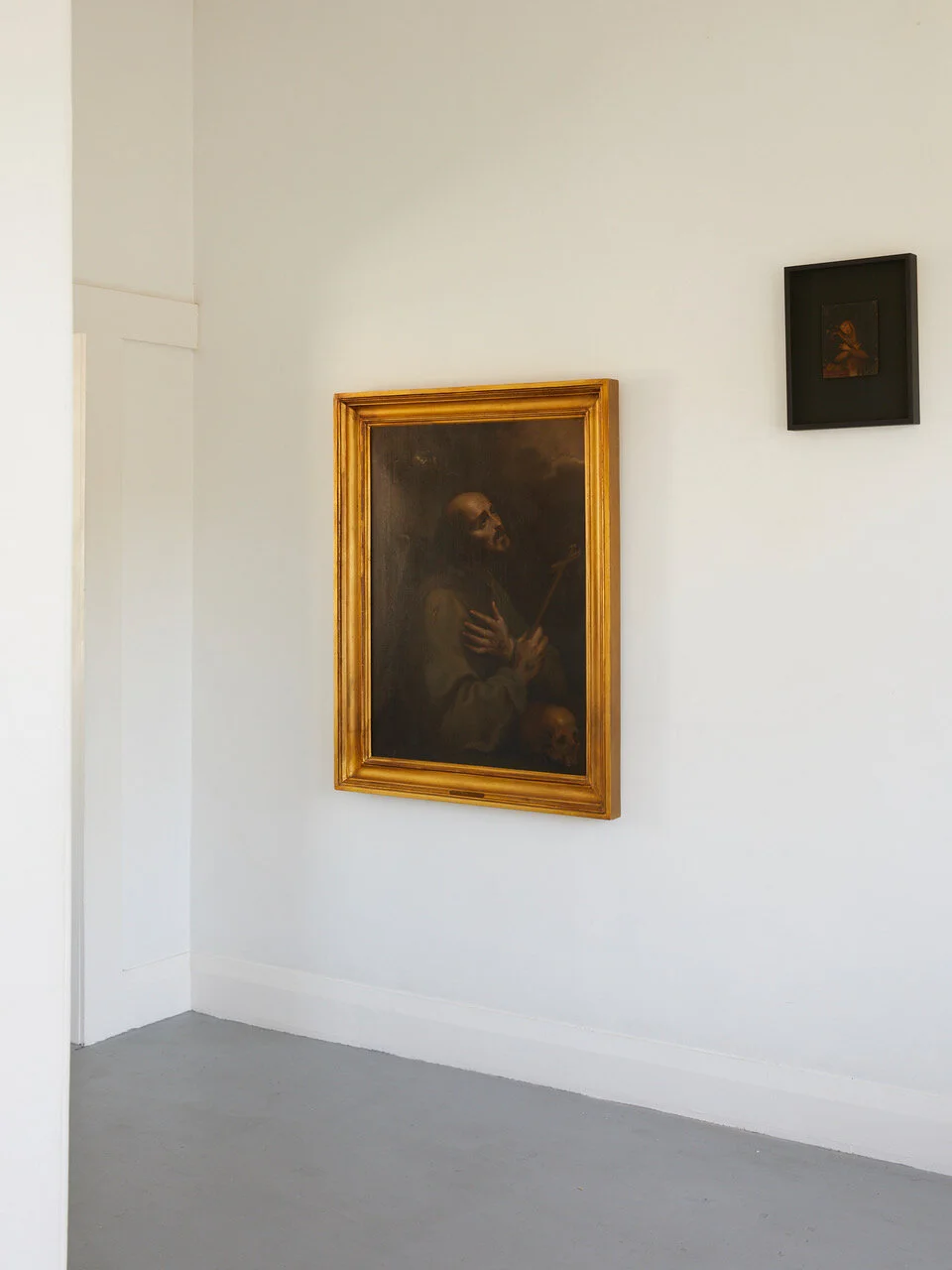
Left to right:
Saint Francis
Late 16th century, Bologna, Italy
945 x 710mm
Saint Catherine of Siena in Meditation
12th - early 13th century, Northern Europe (probably Spain)
180 x 140mm

Left to right:
Marcel Dzama
Neither more nor less or Neither simple nor straightforward
2014
watercolour, gouache, collage and graphite on paper (ex David Zwirner, New York)
430 x 355mm
John Ward Knox
the well
2019
Rimu (Yakisugi treatment), beeswax
155 x 140 x 140mm
Bill Hammond
Strap Buddy at the Bone Shop 3
2015
acrylic on canvas
510 x 510mm

Left to right:
Jason Greig
Matriarchal Mary
2019
charcoal on paper
620 x 430mm
Jason Greig
Scholasticism IV
2019
monoprint 1/1, ink
120 x 120mm
Vanitas with a Monk
17th - 18th century, Continental Europe
170 x 95mm
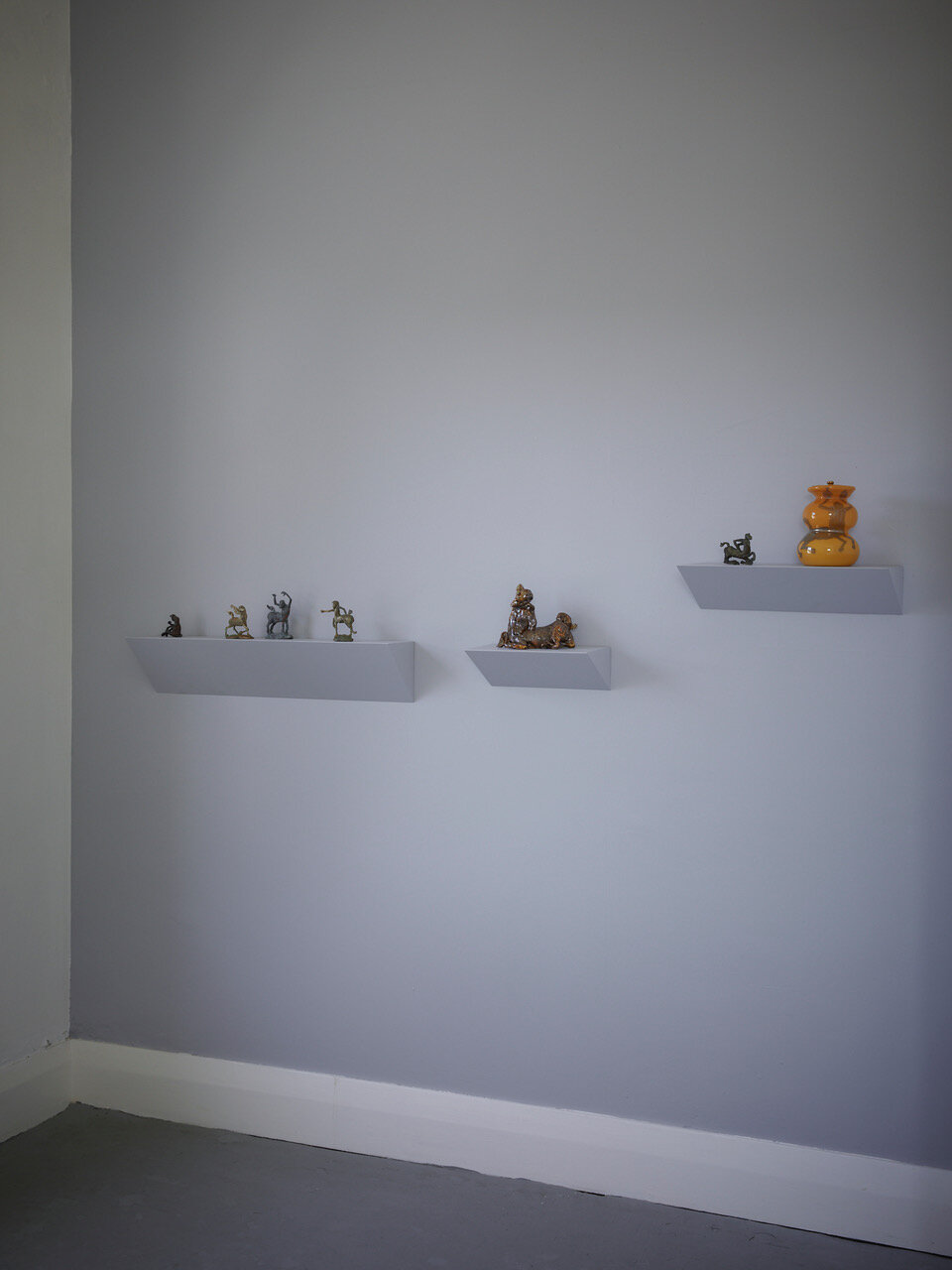
Francis Upritchard



PROVENANCE II
From 26th November 2019
European Antiquities and Old Masters
With:
Bill Henson, Marcel Dzama, Jalal Asgher,
Janet Beckhouse, Kushana Bush,
David Cauchi, Tony de Lautour, Jason Greig,
Louise Greig, Michael Harrison, Andrew McLeod,
Peter Madden, Liz Maw, Tanja Nola, Martin Selman,
Yvonne Todd, Francis Upritchard
Ronnie van Hout, John Ward Knox
Image (left to right):
Bill Henson
Untitled CL SH645 N10
2009/16
archival inkjet pigment print, edition of 5 + 2 AP
1080 x 1330mm
Madonna and Child (Sedes Sapientiae
12th - early 13th century, Northern Europe (probably Spain)
580 x 210 x 170mm
Pieta
17th century, Spain
620 x 440mm
Left to right:
Tony Fomison
Clown
1975
oil on hessian on board
365 x 220mm
Romanesque Statue
Late 13th - early 14th century, Iberian (probably Pyrennes)
590 x 200 x 95mm
The Head of John the Baptist
17th century, Sevillian school (possibly from the workshop of Sebastian de Llanos Valdés)
555 x 770mm
Left to right:
Judith
18th century, Spain or a Spanish colony (possibly Equador)
480 x 330 x 170mm
Tanja Nola
Royal Blue Velvet Pot
2019
raw clay, stoneware, earthenware, porcelain, ceramic pigment and oxide, glass, copper, diamond dust, ceramic scraps
250 x 260 x 280mm
Tanja Nola
Stick Rock Pot
2019
raw clay, stoneware, earthenware, porcelain, ceramic pigment and oxide, glass, diamond dust, ceramic scraps
175 x 290 x 210mm
Scytho-Sarmatian Bronze Vessel
Late Scythian, 3rd - 2nd century BC, Scytho-Sarmatian, Crimea
250 x 210 x 140mm
Yvonne Todd
Geranium
2019
c-type print from 4x5 transparency film, edition of 3 + 2 AP
1200 x 940mm
Left to right:
Roman Red-Slip Terracotta Jug (2)
Late Imperial Period, 3rd century AD, North African (Tunisia)
180 x 120 x 100mm
Campanian Black-Glazed Guttus
Hellenistic period, 2nd half of the 4th century BC, Western Greek, Campania
135 x 150 x 115mm
Roman Red-Slip Terracotta Jug (1)
Late Imperial Period, 3rd century AD, North African (Tunisia)
150 x 101 x 90mm
Apulian Black-Glazed Guttus
Hellenistic period, 2nd half of the 4th century BC, Western Greek, Apulia
130 x 140 x 155mm
Bill Henson
Untitled CL SH645 N10
2009/16
archival inkjet pigment print, edition of 5 + 2 AP
1080 x 1330mm
The Virgin of the Annunciation
15th century, Bohemia (Czech Republic)
430 x 260 x 150mm
Provenance: Private collection, Madrid, Spain.
A very fine carved alabaster statue of The Virgin of the Annunciation, surprised in her spiritual meditations by the apparition of the archangel Gabriel, announcing her conception of the Christ child. This statuette’s sensitively carved features and slight smile, elongated proportions, and graceful draperies show stylistic analogies to courtly art in Paris. In fact, this is a very direct copy of the early 14th century French limestone Virgin of the Annunciation (1300 - 1310, 424 x 296 x 188mm) now housed in the Metropolitan Museum of Art, New York.
A comparable piece was catalogued by the French Haute Epoque expert and art consultant, Laurence Fligny. Fligny designates the piece as Central European, Bohemian or Pomeranean, c. 1420/1430. Both of these pieces would appear to belong to the same period of artistic creativity in early 15th century Bohemia.
King Charles IV of Bohemia (c.1316 - 1378) was determined to rebuild his capital city Prague in the image of Paris and Rome, and to turn it into a hub of learning, spirituality, and the arts. A new generation of Bohemian artists drew specifically on international prototypes (such as the Paris Virgin) to embellish Charles’ building projects. This artistic activity continued well after Charles’ death in 1378. Amongst the many iconic religious images produced around 1400 were a series of paintings and sculptures of ‘Miraculous Madonna’s’, many of whom inspired intense cult followings. These images expressed a distinct aesthetic, known as ‘The Beautiful Style’, which depicted Mary as a courtly medieval princess. These so-called ‘Beautiful Madonna’s’ are characterised by an affected elegance; typically, cascading folds of drapery cover a demure female figure poised in an exaggerated ‘S’ stance. The facial features are similarly distinctive; a girlish face with a high smooth forehead, delicate chin and lips, and almond eyes. The necks are elongated and curved, the shoulders narrow, and the fingers of the hands long and tapering. All of these features are very evident in this sculpture, dating it to the early 1400s. Early alabaster figures almost always show traces of polychromy and/or gilding — or glazing intended to make them resemble bronze, since the most admired and technically impressive statues from antiquity were cast in this material. The patination on this piece is suggestive of this kind of ‘bronze’ glazing.
Marcel Dzama
Neither more nor less or Neither simple nor straightforward
2014
watercolour, gouache, collage and graphite on paper (ex David Zwirner, New York)
430 x 355mm
Martin Selman
Tondo
2019
Carrara marble
750 x 750 x 55mm
Martin Selman
Il Braccio Destro
2019
Carrara marble
260 x 580 x 400mm
Martin Selman
Travertine Fracture
2019
Iranian travertine
180 x 255 x 370mm
Pieta
17th century, Spain
620 x 440mm
Provenance: Private collection, Spain.
Oil on canvas depicting ‘The Piety’; the grieving Virgin Mary cradling the bloodied head of Christ after his descent from the cross. Produced by a follower of the earlier works of Luis de Morales (c. 1512 - 9 May 1586), a Spanish painter born in Badajoz, Extremadura. Known as "El Divino", most of his work depicted religious subjects, including many representations of the Madonna and Child and the Passion. Morales’ paintings were characterised by his stylised, primitive approach to form, and his vivid and expressive representations of physical and emotional pain. These works combined the aesthetics of the Flemish Primitives (such as Van de Weyden) with a darkness that foreshadowed Caravaggio and the Spanish Baroque. Morales was much admired and copied in his lifetime and beyond, and he was one of a number of old masters who inspired the late New Zealand artist Tony Fomison's religious images.
Saint Francis
Late 16th century, Bologna, Italy
945 x 710mm
Provenance: Antichitarte Lda, Caserta, Italy.
Oil on canvas depicting Saint Francis of Assisi in meditation. With a gilded frame bearing a plaque with the attribution ‘Luis Carrache’. This is a reference in French (the painting must have been part of a French collection at one time) to Ludovico Carracci (c. 1555 - 1619).
Born in Bologna in 1555, the son of a butcher, Lodovico Carracci grew up under the same roof as his cousins Agostino (c. 1557-1602?) and Annibale (c. 1560-1609), who became his closest collaborators. Around 1582 Lodovico and his cousins Agostino and Annibale founded an academy that emphasised drawing from life and offered an opportunity to study optics, anatomy, and other subjects considered important to painters. The three artists worked together so closely in their early years that in many cases scholars have found it difficult to distinguish between their hands. A conscious experimentation with style was a hallmark of the early Carracci Academy as the Carracci attempted to reform the formal, affected elegance of the prevailing late mannerist style with an infusion of nature, comprehensibility, human warmth, and authentic expression.
After the departure of his cousins for Rome in the mid 1590s, Lodovico remained in Bologna to head the Carracci Academy and thriving studio. He traveled little and reluctantly. During this period he produced his more significant works, at least in terms of their impact on subsequent generations of artists. The sensuous quality of his paint, the powerful, tangible evocation of solid form, the innovative chiaroscuro, and dynamic approach to composition, opened a path toward the baroque style.
Until the end of his life, Lodovico was inundated with commissions from important patrons both in Bologna and elsewhere in northern Italy, and his works commanded the highest prices. His late style is emphatically didactic and oscillates, depending upon the subject, from the stern and austere to finely-spun ethereal effects. This painting of St Francis seems likely to come from this period, since it is technically sophisticated compared to Ludovico’s earlier works, and combines sombre asceticism with delicate detailing, such as the blue veins in the saints hands, the patination of the skull, and the darkened atmosphere of his cell.
Orthodox Icon of Christ the Pantocrator
Mid-late 18th century, Western Russian (probably St Petersburg)
350 x 265 x 65mm
Provenance: Private family collection of a Russian emigre, Rhode Island, USA.
An Orthodox icon painted in oil on a wooden panel and covered with a heavy, carved, repoussé silver covering (called an oklad). The subject is Christ as the Pantocrator, or teacher of men. This is very common theme in Orthodox iconography, but this particular icon shows Christ in a more sophisticated three-quarter view, as opposed to a frontal view which is the more typical presentation. Traditionally icons were painted in egg tempera and the figuration was highly stylised, but in the mid 18th century the influence of Western portrait painting produced a new type of icon, painted in oils and offering more naturalistic and humanised images. The silver coverings or oklads were commissioned by families for icons which had proven effective in focusing prayers and producing results. In this way the icon was protected (from dirt and smoke from incense and icon lamps) and also honoured.
Drawing by François Boucher
1703-1770, Paris
275 x 370mm
Provenance: Private collection, Spain.
An academic drawing in sanguine chalk depicting a male nude. François Boucher (c. 1703–1770) was a French Rococo painter, engraver, and designer, who epitomised the frivolity, elegance, and extravagance of the French court in the 18th century. His career was hugely successful and he received many honours, becoming Director of the Gobelins factory in 1755 and Director of the Academy and King's Painter in 1765. He was the favourite artist of Louis XV’s most famous mistress, Madame de Pompadour, to whom he gave lessons, and whose portrait he painted several times.
Boucher was also a virtuoso draftsman. Drawings played a large role in the preparation of paintings and as designs for printmakers, as well as being created as finished works of art for the growing market of collectors. For his major canvases, Boucher followed standard studio practices of the time, working out the overall composition and then making chalk studies for individual figures or groups of figures. He was an incredibly productive artist, making thousands of drawings both as sketches and finished works in chalk, ink, and pastels. One of the most notable things about Boucher's superb draughtsmanship is his energetic, economical mark-making. Grace, beauty and power combine with a striking inner force. Such was his popularity that a great number of printmakers found it lucrative to reproduce his paintings and drawings; some 1,500 prints after Boucher are known today.
The Head of John the Baptist
17th century, Sevillian school (possibly from the workshop of Sebastian de Llanos Valdés)
555 x 770mm
Provenance: Private collection, Madrid, Spain.
Oil on canvas of the severed head of John the Baptist, on a metal platter (pewter or copper). Tucked underneath the platter is a thin, crude wooden cross, which is almost always carried by John the Baptist in artistic depictions, and draped over the edge of the plate is a ribbon-like scroll. The severed head is painted in stark pallid tones, which contrast with the deep shadows.
Paintings of the severed heads of martyr saints form part of an artistic tradition that can be traced back to Spanish sculpture from the last quarter of the 16th century. The majority of the painted treatments of this subject were produced by a number of leading Spanish (and especially Sevillian) artists. The earliest known painting of a severed martyr's head is a work by Jusepe de Ribera (1591-1652) of around 1636, depicting The Head of Saint John the Baptist, today in the Real Academia de San Fernando, Madrid. In Seville, Francisco de Zurbarán (1598-1664) painted a set of severed heads of saints for the main altar of the Iglesia de los Mercedarios Descalzos, and in around 1650 Herrera el Viejo (1576-1656) painted two severed heads of saints, one of which is today in the Prado Museum. The majority of unsigned paintings of saintly severed heads from this period were once attributed to Juan de Valdés Leal, but subsequent scholarship concluded that they are most likely to be the work of a student of Herrera el Viejo called Sebastian de Llanos Valdés (c. 1605–1677). It appears that he carved out something of a niche for himself painting severed heads for private patrons.
Valdés' oeuvre consists almost entirely of religious imagery, and his style reflects the artistic traditions of his time, including the deep chiaroscuro used by the ‘Spanish Caravaggio’, Zurbarán. Within Valdés' artistic production lies a significant group of severed heads of martyr saints, most of which appear to date from the 1660s and 1670s. Valdés paints with intense realism, conveying the full physical horror of martyrdom — the decapitated heads displaying a palpable sense of rigor mortis and the pewter dishes splattered with blood from the severed necks. These qualities are very evident in this work, with the lividity of the facial flesh and the grotesquely gaping jaw. It is possible that this painting comes at least from the workshop of Sebastián de Llanos Valdés, if not actually from his own hand.
Romanesque Statue
Late 13th - early 14th century, Iberian (probably Pyrennes)
590 x 200 x 95mm
Provenance: Private collection, Madrid, Spain.
A wooden sculpture of a seated male figure, wearing a conical hat, long robe, and cape. This is almost certainly a representation of Saint Peter as the first pope of the Catholic Church. An inverted ‘T’ shaped object rests diagonally against his legs, symbolising Saint Peter’s martyrdom – he was crucified upside down. These images of Saint Peter as Pope were common until the 14th century. The sculpture is very distressed; both arms and feet are missing, as is most of the nose. Traces of polychromy are visible in the dark patina, and the painting of the eyes is still distinct.
The Romanesque world extended roughly from about the late 10th century to around 1200. In Spain, it flourished in the northern half of the country and is notable by its absence in the south, which, despite advances made by the Christian kingdoms of the north, was still firmly held by Muslim al-Andalus. The aesthetic of the piece is characteristic of Romanesque culture – heavily stylised, rigid, and imposing. Its relative simplicity and lack of refinement in the detailing suggest that it is a popular, folk art version of the Romanesque high art made for Cathedrals and noble homes during this period.
Christ Child with Instruments of the Passion
17th - 18th century, Iberian Peninsula School
620 x 495mm
Provenance: Private collection, Madrid, Spain.
Oil on canvas depicting the young Christ child walking alone in a darkening landscape, wearing a red robe and a crown of thorns, and carrying a wooden cross. He looks upwards to Heaven, and emanating from his head are faint rays in the shape of the Tres Potencias (symbolising the three Powers of the Lord: authority, ability, and strength). This is an allegorical painting, most likely commissioned for private devotion, and intended to inspire sympathy and pity for Christ’s suffering. This type of painting seems to have been very popular in the Iberian Peninsula and the Spanish and Portuguese colonies in the 18th and 19th centuries. There are several set pieces of this nature in popular Catholic art which relate to the idea of Christ’s martyrdom being predestined, and which depict Christ as a small child in the presence of symbols of the Passion. One such set piece depicts him sleeping next to a skull (the skull of Adam, often appearing in art at the foot of the cross); another depicts him pricking his finger or foot with a thorn; and another depicts him carrying his cross and sometimes the crown of thorns. This particular painting falls into the latter category of set piece. It is very finely painted, and the Christ child has been rendered with a softness and emotionality which juxtaposes his innocence with the harshness of his fate.
Virgin del Populo
18th century, Continental Europe (most likely Southern Spain or Italy)
160 x 130mm
Provenance: Private collection, Madrid, Spain.
Catholic icon of the Virgin Mary holding the Christ Child, painted in oils on a heavy gauge copper sheet, with a thick application of gilding in the background. The young Jesus is making a gesture of benediction (blessing). This is one of many copies made of an original icon supposedly painted by Saint Luke (who, according to Catholic tradition, was the first icon painter). St Luke’s original version is reputed to have miraculously ended a plague epidemic in Rome in 1231, and thereafter was known as the Sales Populi Romani (The Salvation of the Roman People). The Virgin del Populo became one of the most popular Marian icons through the centuries, attracting many pilgrims to the church of Santa Maria del Populo in Rome, where it is still housed today.
Copies of both Catholic and Orthodox icons — even the smallest and crudest — are felt by the faithful to share something of the miraculous qualities of the original. Hence there was a proliferation of large and small copies of The Virgin del Populo throughout the Catholic world, stretching as far as Eastern and Northern Europe, and the New World. The Virgin del Populo was specially venerated in Italy and Southern Spain, particularly Seville and Cadiz. The sheer popularity of this image makes it hard to determine the origin of this particular version: however, given its provenance, it is most likely to be Spanish.
Bill Hammond
Strap Buddy at the Bone Shop 3
2015
acrylic on canvas
510 x 510mm
Tanja Nola
Bam Bam Chalice Pot
2019
raw clay, stoneware, earthenware, porcelain, ceramic pigment and oxide, glass, ceramic scraps
225 x 340 x 290mm
Tanja Nola
Royal Blue Velvet Pot
2019
raw clay, stoneware, earthenware, porcelain, ceramic pigment and oxide, glass, copper, diamond dust, ceramic scraps
250 x 260 x 280mm
Tanja Nola
Stick Rock Pot
2019
raw clay, stoneware, earthenware, porcelain, ceramic pigment and oxide, glass, diamond dust, ceramic scraps
175 x 290 x 210mm
Jalal Asgher
Theda Bara
2019
graphite on paper
320 x 260mm
Jalal Asgher
Musidora
2019
graphite on paper
300 x 250mm
Peter Madden
A Requiem
2019
mixed media collage on board
810 x 710 x 90mm
Memento Mori Plaque (possibly a Plague Marker)
Possibly 17th - 18th century, Barcelona, Spain
1010 x 540 x 95mm
Provenance: Private collection, Barcelona, Spain.
A large wooden plaque, painted black, with a stark, striking skull and crossbones painted in white. The upper section is arched and there is extensive damage to the wooden structure. The skull and crossbones motif and cruder, stylised execution suggest that this plaque could possibly be a ‘plague marker’, or makeshift memorial for the plague dead, who were most often buried in mass graves. Barcelona reportedly had insufficient space in its cemeteries for the plague dead, and as a consequence, many of the mass graves were located in churchyards or under the floors of the churches themselves. This is perhaps the most likely context for a wooden plague marker.
Tony de Lautour
Lightning Inventory I
2019
oil and acrylic on wood
430 x 370mm
Tony de Lautour
Lightning Inventory II
2019
oil and acrylic on wood
430 x 370mm
John Ward Knox
the well
2019
Rimu (Yakisugi treatment), beeswax
155 x 140 x 140mm
Yvonne Todd
Geranium
2019
c-type print from 4x5 transparency film, edition of 3 + 2 AP
1200 x 940mm
Roman Red-Slip Terracotta Jug (2)
Late Imperial Period, 3rd century AD, North African (Tunisia)
180 x 120 x 100mm
Provenance: Private collection, Munich, Germany.
Roman narrow-mouthed piriform vessel distinctive of the North African pottery industry (now modern day Tunisia), with handle and a small foot. Applied relief decoration on the body consisting of three vertical dividing laurel branches with an eagle and a dancing male figure in between, and an arched floral garland above each figure.
Roman Red-Slip Terracotta Jug (1)
Late Imperial Period, 3rd century AD, North African (Tunisia)
150 x 101 x 90mm
Provenance: Private collection, Munich, Germany.
Roman narrow-mouthed piriform vessel distinctive of the North African pottery industry (now modern day Tunisia), with handle and a small foot. Applied relief decoration on the body consisting of two vertical dividing palm branches between which are two figures of Faunus (Roman equivalent of Pan) wrestling with an animal. The handle is restored, but the vessel is otherwise intact.
Liz Maw
Old Money 3
2019
coloured pencil on paper
390 x 275mm
Liz Maw
Old Money 4
2019
coloured pencil on paper
390 x 275mm
Kushana Bush
Just to be loved equally
2019
gouache and watercolour on paper
190 x 270mm
Francis Upritchard
Boo Centaur
2019
Shibuichi (93% copper, 7% silver)
120 x 75 x 25mm
Francis Upritchard
Forward Centaur
2019
Shibuichi (93% copper, 7% silver)
100 x 105 x 30mm
Francis Upritchard
Hooray Centaur
2018
glass, metal lustre
185 x 130 x 135mm
Madonna and Child (Sedes Sapientiae)
12th - early 13th century, Northern Europe (probably Spain)
580 x 210 x 170mm
Provenance: Private collection, Spain.
A softwood Madonna and Child statue, heavily distressed but essentially intact, with traces of polychromy (probably egg tempera). Both figures are rendered in the typical Romanesque style; the composition is formal and frontal, with the Christ child sitting on the Madonna’s left knee. She holds a pomegranate with her right hand, symbolic of the blood and resurrection of Christ, and the Christ’s right arm is raised, his hand making the gesture of benediction (blessing). The Madonna’s face is massive and mask-like, as is that of the Christ, emphasising that they are eternal presences rather than ordinary human beings. As in Byzantine iconography — from which the Romanesque style is derived — the primitive, highly stylised rendering of the Madonna and Child serve to accentuate their sheer spiritual power.
The figure of the Virgin and Child enthroned was a hugely popular iconographical theme particularly during the Middle-Ages. Throughout the 12th century, the Virgin Mary appears in churches all over Europe (France, Germany, Belgium, Scandanavia, England, Italy and Northern Spain) sitting majestically, her body forming Christ’s throne. This kind of presentation is called Sedes Sapientiae, meaning The Throne of Wisdom.
Portrait of an Elderly Nun
18th century, Northern Italy
405 x 320mm
Provenance: Private collection, Genoa, Italy.
A portrait in oil on a wooden panel depicting an elderly Carmelite nun, possibly post-mortem. Portraits of nuns were common in Catholic countries such as Spain — and to a lesser extent, Italy — but particularly in the Spanish colonies of the New World, where nuns enjoyed high standing in society. These portraits tended to be commissioned at very specific stages in the lives of the nuns; for instance, wealthy families often commissioned portraits of their daughters before they entered the convent, in full ‘civilian’ finery, and then afterwards on the occasion of their formal profession of vows. Nuns who had led exemplary lives were also commemorated in portraiture after death, and these were typically displayed within the convent walls. Occasionally, a professional portrait painter would be commissioned to paint a nun (the most famous example being the young Diego Velazquez (1599-1660), who painted three portraits of the elderly Franciscan nun, Jerónima de la Fuente). But most often the painter would be a nun from within the convent (girls with artistic or scholarly inclinations were often drawn to religious orders).
Saint Catherine of Siena in Meditation
17th - 18th century, Continental Europe (probably Spain or Italy)
180 x 140mm
Provenance: Private collection, Madrid, Spain
Catholic icon painted in oils on copper sheet. It depicts the saint Catherine deep in meditation, wearing her characteristic Dominican robes. She holds her usual attributes, a stem of lilies and a crucifix, and is shown before an altar or table upon which a bible lies open. Saint Catherine of Siena was a Dominican tertiary and mystic who lived in Italy in the 1300s. She was known for her holiness, asceticism, and spiritual visions, and was said to have received stigmata. She was also a reformer and political activist, and was influential in both the religious and political affairs of the church. Her image was popular as the subject of small paintings like this, intended for use in the homes of the Catholic faithful.
Scytho-Sarmatian Bronze Vessel
Late Scythian, 3rd - 2nd century BC, Scytho-Sarmatian, Crimea
250 x 210 x 140mm
Provenance: Private collection, South Germany; Exhibition Bonn (2013) p. 259 cat III.10 (Tavrida Central Museum Simferopol, Inv. D-17765 HB).
Scytho-Sarmatian bronze vessel with high foot, conical base, and an oval basin with two handles, each with three protuberances. The surface has a blackish-green patina, and there is a crack beside one handle and a small hole in the base, which shows some evidence of an old repair. The Scythians and Sarmatians were two closely related peoples who populated the Eurasian steppe from roughly the 9th century BC to the 3rd century AD. Both lived in nomadic pastoral societies and were feared in antiquity as formidable horse-back warriors — Scythian warrior women are speculated to have been the historical inspiration for the Amazons of Greek mythology. They are known for producing masterful metalwork, particularly in bronze and gold. Archaeological and documentary evidence also shows that Scytho-Sarmatian peoples adorned themselves in tattoos, enjoyed smoking hemp, drinking wine and fermented mares’ milk.
Michael Harrison
King and Queen of Swords
1999
acrylic on paper
300 x 250mm
Campanian Black-Glazed Guttus
Hellenistic period, 2nd half of the 4th century BC, Western Greek, Campania
135 x 150 x 115mm
Provenance: L.J. collection, Netherlands; Private collection, USA.
Campanian black-glazed guttus made from toned clay with ribbed body and ring handle. Decorated with moulded medallion of a satyr head with goat horns. Satyrs were part of the Thiasus, or entourage of the god Dionysus. The surface is partially rubbed, but the guttus is otherwise intact. Western Greek is a term, which refers to objects produced in Greek colonies in Southern Italy. These small vessels were used to slowly pour liquid in drops — probably in the context of religious rituals such as sacrifices.
Apulian Black-Glazed Guttus
Hellenistic period, 2nd half of the 4th century BC, Western Greek, Apulia
130 x 140 x 155mm
Provenance: Private collection, West Germany.
Apulian black-glazed guttus made from toned clay with ribbed body and ring handle. Decorated with a plastically moulded frontal bust of Pallas Athena, the Olympian goddess of wisdom and war, amongst other things. There are two small chips on the foot of the vessel, but it is otherwise intact. Western Greek is a term which refers to objects produced in Greek colonies in Southern Italy. These small vessels were used to slowly pour liquid in drops — probably in the context of religious rituals such as sacrifices.
Jason Greig
Matriarchal Mary
2019
charcoal on paper
620 x 430mm
Bronze Enkolpion
Middle Byzantine Period, 10th - 12th century AD, Byzantium (Eastern Roman Empire)
60 x 40 x 5mm
Provenance: Private collection, Munich, Germany.
Half of a bronze enkolpion (medallion) with engraved figure standing in the attitude of Orans (a posture of prayer and supplication) and wearing a long robe, with nimbus and cross, and two stars flanking each hand of the figure. Green patina, minor damages at the hinges. These cruciform reliquaries were worn around the neck and many were produced in such a way as to hold a secondary relic (such as a piece of a saint’s clothing or hair, or a piece of the True Cross). They are believed to have substituted the use of bullae (pendants containing amulets against incantations), which were worn by Romans prior to Christian conversion. In this way, it can be regarded as an object, which bridges the Graeco-Roman and Christian worlds presented in Provenance II.
Bill Hammond
Colour Plate
1996
crayon on paper
600 x 735mm
Alabaster Triptych
Italy
320 x 475 x 95mm
Provenance: Private collection, Madrid, Spain
A travelling icon with fine bas-relief carving on alabaster, mounted on three hinged panels covered with deep red velvet. The central panel depicts the Virgin and Child in a loving pose which may have been inspired by Donatello’s (1386-1466) Pazzi Madonna (1420). The wings of the triptych each depict two of the four evangelists, holding scrolls representing their gospels. The aesthetic of the figures is very much in the style of 14th - 15th century Catholic iconography.
Vanitas with a Monk
17th - 18th century, Continental Europe
170 x 95mm
Provenance: Private collection, Spain.
A very distressed painting in oils on copper sheeting, depicting a skeletonised monk in a white robe praying before a crucifix. Images of ‘living skeletons’ like this piece are part of a larger tradition of darkly satirical Vanitas images on the theme of mortality and the ultimate vanity of human activity.
The Divine Child
16th - early 17th century, Spain
250 x 125 x 95mm
Provenance: Private collection, Madrid, Spain.
A small, very early wooden sculpture of the infant Jesus. Heavily patinated with old losses to the paintwork and gesso on the knees, torso and face, and is missing both arms (which seem to have been carved separately and attached in such a way that they could be manipulated to create different gestures). The hair is deeply carved into curls and the legs are crossed in a sitting position. The face is more crudely fashioned, with the eyes protruding from the plane of the face, whereas later pieces would probably have had inset glass eyes. This piece could have originally been part of a large Madonna and Child grouping — held aloft in the arms of the Madonna. Alternatively, it could possibly have been a stand alone piece representing the Santo Nino or ‘The Divine Child’, possibly with one hand holding a blue globe representing the world, and the other raised in the gesture of benediction (blessing).
David Cauchi
The Look
2019
oil, watercolour and coloured pencil on linen
400 x 300mm
Andrew McLeod
Areez with marble relief
2019
oil on linen
400 x 555mm
Left to right:
Madonna and Child (Sedes Sapientiae)
12th - early 13th century, Northern Europe (probably Spain)
580 x 210 x 170mm
Pieta
17th century, Spain
620 x 440mm
Left to right:
Liz Maw
Old Money 3
2019
coloured pencil on paper
390 x 275mm
Liz Maw
Old Money 4
2019
coloured pencil on paper
390 x 275mm
Tanja Nola
Royal Blue Velvet Pot
2019
raw clay, stoneware, earthenware, porcelain, ceramic pigment and oxide, glass, copper, diamond dust, ceramic scraps
250 x 260 x 280mm
Left to right:
Christ Child with Instruments of the Passion
17th - 18th century, Iberian Peninsula School
620 x 495mm
Yvonne Todd
Geranium
2019
c-type print from 4x5 transparency film, edition of 3 + 2 AP
1200 x 940mm
Left to right:
Saint Francis
Late 16th century, Bologna, Italy
945 x 710mm
Saint Catherine of Siena in Meditation
12th - early 13th century, Northern Europe (probably Spain)
180 x 140mm
Left to right:
Marcel Dzama
Neither more nor less or Neither simple nor straightforward
2014
watercolour, gouache, collage and graphite on paper (ex David Zwirner, New York)
430 x 355mm
John Ward Knox
the well
2019
Rimu (Yakisugi treatment), beeswax
155 x 140 x 140mm
Bill Hammond
Strap Buddy at the Bone Shop 3
2015
acrylic on canvas
510 x 510mm
Left to right:
Jason Greig
Matriarchal Mary
2019
charcoal on paper
620 x 430mm
Jason Greig
Scholasticism IV
2019
monoprint 1/1, ink
120 x 120mm
Vanitas with a Monk
17th - 18th century, Continental Europe
170 x 95mm
Francis Upritchard
































































